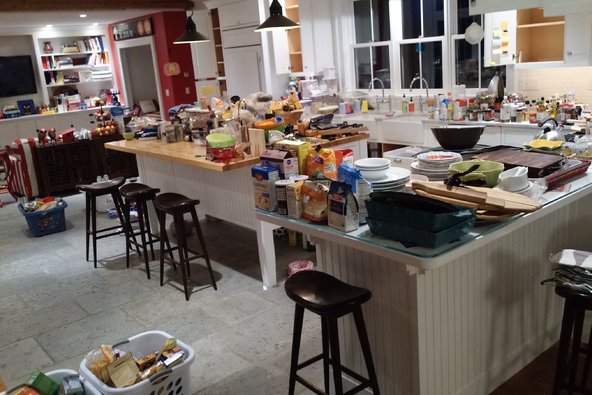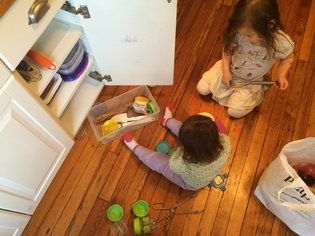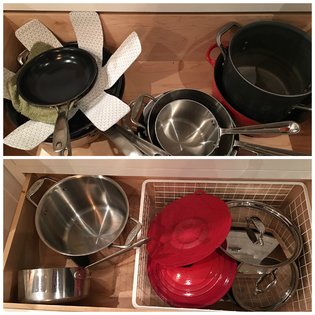
KJ Dell’Antonia’s kitchen, en route to tidiness. The process took 10 days.Credit
My kitchen wasn’t awful. Many nights, the clutter on the counter was arranged quite neatly. Most of the cabinets closed. We could cook in it, and did, with joy.
But the cleaning up process never made me happy. I hated the shifting and wedging of pans into drawers and the way the cornstarch always turned up the day after I’d purchased a new box. My four kids seemed to feel that if fruit could be stored in a basket on the counter, so could their iPod chargers, recently acquired party favors and math homework.
I wasn’t the only one who was feeling the need for a kitchen makeover. Margaux Laskey, my partner in the Kids Cook column, was having similar thoughts. Although we’re both working parents who love to cook, we’re in different places in our lives: She’s the mother of a baby and a preschooler, while my kids are older (9, 10, 11 and 14). Her kitchen is small, mine is the big country version. Did we also need different approaches to a kitchen clean-out?
We thought we did. So while I went in for what we called the “full Kondo,” using the destroy and discard before storing and making beautiful method advocated by Marie Kondo, author of “The Life-Changing Magic of Tidying Up” and “Spark Joy: An Illustrated Master Class On the Art of Organizing and Tidying Up,” Margaux tried the less regimented one-thing-at-a-time approach encouraged by Fay Wolf in her book, “New Order: A Decluttering Handbook for Creative Folks (and Everyone Else).”
Result? We’re both feeling pretty successful — and like we made the right choice. Here’s how our kitchen organizing adventures went:
KJ: I’d arranged our kitchen when we first moved into the house two years ago, before we built a pantry. It’s a beautiful kitchen, with lots of counter space — and little storage that I can reach without a stepstool. I made it work, but things were scattered. The baking dishes lived on the basement stair shelves, the spices in three different places, canned goods in that one cabinet than combined height and depth in a way that turned it into the storage equivalent of a black hole. I decided to bring it all back together, and follow Marie Kondo’s core advice: “gather everything that belongs in the same category in one place, and keep only those things that bring you joy.” Her method — get it all out, discard what you don’t love, and then, and only then, arrange what’s left — would work for me.
Margaux: As KJ said, we have a small kitchen, with a tragically tiny counter space, but we are lucky enough to have high ceilings with decent-sized cabinets. This is good because we love to cook, so we have room for all of our appliances and ingredients, but unfortunate because things get lost in those top cabinets (hello, steel-cut oatmeal from 2009!), and I always end up buying way more than we need. The worst offender was my spice cabinet, with the food storage container and sippy cup cabinet coming in at a close second. I was regularly terrified to open the spice cabinet for fear I might get brained by the pepper grinder, and my husband, who is the primary dishwasher and putter-away-er, was buried daily by the sippy cup/food storage avalanche. Both needed some serious revamping. With two little kids into everything, I knew Ms. Kondo’s approach would not work for me. I immediately connected with Ms. Wolf’s “just start” and “do what you can in 10-20-30 minute increments” approach. This, I thought, I can do.
KJ: To coin a phrase, that which you wish to tidy, you must first destroy. I gathered — by which I mean I took every single kitchen- or food-related item out of every single drawer or cupboard, off the shelves in the basement, out of the storage area back by the garage and everywhere else. Things the dogs wouldn’t eat I put on the floor in laundry baskets by category, the rest covered the counters and table. Because the rest of life didn’t stop, it took four days just to get it all out in the open, and the result was an extraordinary mess — apparently a step in the right direction.
“Some people’s instinct is to tidy for a certain number of available hours, then ‘clean up from their tidying’ and put the items they are keeping back in their place,” Ms. Kondo told me by email. “With this approach, not only will tidying take you much, much longer, it’s quite possible that you will never finish. So I am saying that it’s really OK, in fact it’s better to keep an area messy while you are tidying that category of items.”
Margaux: One night after bedtime, I took out all 50 or so spices and lined them up in alphabetical order on the kitchen table. I consolidated those that I had multiples of (cinnamon, cinnamon, dear God, the cinnamon), tossed those I would never use (a 20-year old bottle of petrified Crazy Jane’s Mixed Up Salt because it reminded me of my late mother?) and wiped down all those remaining. I scrubbed down the inside of the cabinet and put in my new pair of three-tier cabinet organizers. (Ms. Wolf strongly believes that you should hold off on buying organizing products before de-cluttering, but in this case, I went with my gut. I knew there was no way I’d be able to fit all of those spices back into my cabinet without some shelves, and the ones I’d been using were wobbly.) I put my spices back in to the cabinet and, the heavens parted. That was two weeks ago, and I still can’t stop opening my cabinet to gaze adoringly at the little soldiers. It took me about one hour total. (Ms. Wolf suggests using a timer for accountability and action. I just kept an eye on the clock.) This was getting to be fun.
KJ: With my cabinets so beautifully clean and empty, the temptation was strong to start filling them up again (especially given the state of the kitchen). “Think about where to put things away ONLY after you are finished with deciding what you will keep and what you will throw away,” Ms. Kondo said firmly in her email. Counter by counter, basket by basket, I went through things. We don’t need “kid dishes” anymore, although I kept some plastic plates we all love and use. We had far more bike water bottles than we could possibly need, and large quantities of plastic storage containers without lids and lids to missing plastic storage containers. Broken wooden spoons and spatulas that came apart at the mere glimpse of cake batter? Gone. The gravy boat I use one a year? Staying — because once a year, I really want that gravy boat.

Margaux Laskey’s daughters help her get organized.Credit Margaux Laskey
Margaux: Ms. Wolf says “Decluttering is a gateway drug,” and in my case, she is certainly right. After that initial success, I wanted to keep going. If an organized spice cabinet made preparing meals so much easier and less stressful, what would a more organized everything life feel like? I tackled my next project as the big blizzard hit. My husband was outside shoveling, and I was inside with the girls. Could I de-clutter with two kids underfoot?
I sated the girls with small bowls of Cheerios and Cheez-Its, while I tackled the sippy cup/food storage cabinet. I quickly made my way through the cabinet, tossing cups without straws, straws without cups, then any cups that we just never use. By the time I was done, we went from about 12 sippy cups to six. (Still too many? Probably.) I enlisted the help of the girls by asking them to put this or that in the trash, recycling or donations bag. We were done in 10 minutes. I still had time to clean off the layers of children’s artwork, old photos and receipts on the fridge and go through the kitchen paper “organizer” before a tired and dripping husband came through the door.
KJ: Once my discarding was complete (and in the trash, out the door to be donated or otherwise re-homed), I took time to really think about where I wanted the things in our kitchen to be. What did the kids need to be able to reach easily to cook for themselves? How could it be an easier place for the family to work in all together?
Ms. Kondo gets very specific on the subject of kitchens. Focus, she suggests, not on ease of use, but ease of cleaning. I’d always bought into the idea that cooking required having ingredients close at hand, but she suggests trying a different way, and planning to get things out before cooking and replace them.
She’s specifically talking about avoiding easily grease-splattered storage on the counter near the stove, but I applied the same advice to deciding where to store things. Most kitchens have a clear “spice cupboard” by the stove, but not ours. There’s only one cabinet within reach of the stove, and it’s also the only cabinet near the dishwasher. Using it for spices, as I had been, limited the places I could put dishes I needed kids to be able to reach (both to use, and to put away). Instead, I put the mugs we use daily there (they’d been on a higher shelf) and put all the spices except the four things I actually do grab and use (vegetable oil, olive oil, salt and pepper) while cooking in a different place. That was almost a month ago now, and Ms. Kondo is right. “When you are in a kitchen that is easy to clean, one that always looks spick-and-span, the effort of removing things from the cupboard doesn’t seem stressful at all.”
Margaux: I applied some of Ms. Wolf’s tactics outside the kitchen as well. One chapter in her book discusses how to cut down on digital clutter. Me? I had an email problem. A 48,000+ emails-in-my-inbox problem. Wolf suggests unsubscribing from newsletters/promos “like it’s your job.” I did that. She also suggests archiving emails (you can always get them back again if you really need them). I did that. I now have four emails in my inbox, and I only get a few promotional emails a day now as opposed to the 100/day I used to get. I also cleared out more than half of my closet last Saturday night. It was hard to let go of that red silk dress that accompanied me to so many weddings, but Ms. Wolf encourages you to “be brutal in letting go,” so out it went.

Drawers in KJ Dell’Antonia’s kitchen, with pans and lids tidily stored.Credit
KJ: It took 10 full days before the kitchen was restored to order. Taking all that time did result in a truly organized kitchen, one that can be restored to rights easily every night, and one where my children seem less likely to leave clutter.
But — and it’s a big but — it would have been very difficult to do it this way when the children were younger. We had laundry baskets full of heavy, tempting breakables scattered around on the floor for days; moving them into another room or out of reach would have made the process more difficult, and it would probably have taken even longer. The “Konmari method,” as Ms. Kondo calls it, worked well for me now — so well that I’m only a few categories away from an entirely tidy house, and we’re all feeling the difference that being able to put things “away” instead of “somewhere” makes. That said, I have a lovely place to put our Christmas decorations away — but they’re still adorning the house, so this may take a while.
Margaux: I’m not done yet. This is definitely a process, the development of a new habit that I’m hoping will stick. Next up is the dish cabinet (Ms. Wolf endorses tangible rewards to keep you jazzed, so ours will be a new matching set of dishes — after six years of marriage, we’re still eating off a hodgepodge collection). Then, the junk drawer, the vitamin/medicine drawer and the dog food/office supplies/cleaning supplies cabinet.
But it already feels like a new kitchen. There is order. There is space. I truly feel more relaxed, more restful, happier even, and my husband loves the results too. I’m guessing my girls sense this as well, and I hope we’re teaching them some valuable organizational habits, and more important, to be mindful about the items they choose to buy and bring into our house. I can already imagine the cost-benefit ratio discussion my older daughter and I will be having in the Target toy aisle this Saturday.
Tips from Fay Wolf:
Food/spice storage: Wolf is not a big proponent of buying organizational products – in most cases she likes clients to use what they have, shoeboxes, gift boxes, etc. – but thinks that if any room would benefit from a few simple organizational products, it’s the kitchen. She believes that If you can’t see it, you won’t use it, so If a set of cheap shelves can help you see what’s in your spice cabinet/canned goods cabinet/refrigerator/freezer, go for it (but only after you toss out all of the expired goods!).
Children’s artwork: Designate a folder to keep special works of art, and return to it every month or so to curate (sometimes you’ll find that the one picture you just had to keep, you don’t really need to keep anymore). Archive those you don’t keep using Flickr or an app like ArtKive. Think of it as an evolving process.
Decluttering with kids: Don’t hesitate to involve them even if you have to offer them rewards to help. Worse comes to worst, it’s O.K. to put them down in front of the TV for an hour. “You can’t do something out of the ordinary without having to shift the variables,” Wolf said.







